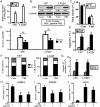VHL regulates the effects of miR-23b on glioma survival and invasion via suppression of HIF-1α/VEGF and β-catenin/Tcf-4 signaling
- PMID: 22649212
- PMCID: PMC3408255
- DOI: 10.1093/neuonc/nos122
VHL regulates the effects of miR-23b on glioma survival and invasion via suppression of HIF-1α/VEGF and β-catenin/Tcf-4 signaling
Abstract
Aberrant microRNA expression has been implicated in the development of human cancers. Here, we investigated the oncogenic significance and function of miR-23b in glioma. We identified that the expression of miR-23b was elevated in both glioma samples and glioma cells, indicated by real-time polymerase chain reaction analyses. Down-regulation of miR-23b triggered growth inhibition, induced apoptosis, and suppressed invasion of glioma in vitro. Luciferase assay and Western blot analysis revealed that VHL is a direct target of miR-23b. Restoring expression of VHL inhibited glioma proliferation and invasion. Mechanistic investigation revealed that miR-23b deletion decreased HIF-1α/VEGF expression and suppressed β-catenin/Tcf-4 transcription activity by targeting VHL. Furthermore, expression of VHL was inversely correlated with miR-23b in glioma samples and was predictive of patient survival in a retrospective analysis. Therefore, we demonstrated that downregulation of miR-23b suppressed tumor survival through targeting VHL, leading to the inhibition of β-catenin/Tcf-4 and HIF-1α/VEGF signaling pathways.
Figures







Similar articles
-
miR-92b controls glioma proliferation and invasion through regulating Wnt/beta-catenin signaling via Nemo-like kinase.Neuro Oncol. 2013 May;15(5):578-88. doi: 10.1093/neuonc/not004. Epub 2013 Feb 14. Neuro Oncol. 2013. PMID: 23416699 Free PMC article.
-
MiR-24 regulates the proliferation and invasion of glioma by ST7L via β-catenin/Tcf-4 signaling.Cancer Lett. 2013 Feb 28;329(2):174-80. doi: 10.1016/j.canlet.2012.10.025. Epub 2012 Nov 7. Cancer Lett. 2013. PMID: 23142218
-
TCTP promotes glioma cell proliferation in vitro and in vivo via enhanced β-catenin/TCF-4 transcription.Neuro Oncol. 2014 Jan;16(2):217-27. doi: 10.1093/neuonc/not194. Epub 2013 Dec 4. Neuro Oncol. 2014. PMID: 24311645 Free PMC article.
-
RUNX3 inhibits glioma survival and invasion via suppression of the β-catenin/TCF-4 signaling pathway.J Neurooncol. 2018 Oct;140(1):15-26. doi: 10.1007/s11060-018-2927-0. Epub 2018 Jun 18. J Neurooncol. 2018. PMID: 29916101 Review.
-
MicroRNA-146 family: Molecular insights into their role in regulation of signaling pathways in glioma progression.Pathol Res Pract. 2024 Dec;264:155707. doi: 10.1016/j.prp.2024.155707. Epub 2024 Nov 7. Pathol Res Pract. 2024. PMID: 39536541 Review.
Cited by
-
The role of transcriptional coactivator TAZ in gliomas.Oncotarget. 2016 Dec 13;7(50):82686-82699. doi: 10.18632/oncotarget.12625. Oncotarget. 2016. PMID: 27764783 Free PMC article.
-
miR-23b and miR-27b are oncogenic microRNAs in breast cancer: evidence from a CRISPR/Cas9 deletion study.BMC Cancer. 2019 Jun 28;19(1):642. doi: 10.1186/s12885-019-5839-2. BMC Cancer. 2019. PMID: 31253120 Free PMC article.
-
MiR-1248: a new prognostic biomarker able to identify supratentorial hemispheric pediatric low-grade gliomas patients associated with progression.Biomark Res. 2022 Jun 17;10(1):44. doi: 10.1186/s40364-022-00389-x. Biomark Res. 2022. PMID: 35715818 Free PMC article.
-
UVA and UVB irradiation differentially regulate microRNA expression in human primary keratinocytes.PLoS One. 2013 Dec 31;8(12):e83392. doi: 10.1371/journal.pone.0083392. eCollection 2013. PLoS One. 2013. PMID: 24391759 Free PMC article.
-
Long non-coding RNA HOTAIR promotes glioblastoma cell cycle progression in an EZH2 dependent manner.Oncotarget. 2015 Jan 1;6(1):537-46. doi: 10.18632/oncotarget.2681. Oncotarget. 2015. PMID: 25428914 Free PMC article.
References
-
- Bartel DP. MicroRNAs: target recognition and regulatory functions. Cell. 2009;136(2):215–233. doi:10.1016/j.cell.2009.01.002. - DOI - PMC - PubMed
-
- Lewis BP, Burge CB, Bartel DP. Conserved seed pairing, often flanked by adenosines, indicates that thousands of human genes are microRNA targets. Cell. 2005;120(1):15–20. doi:10.1016/j.cell.2004.12.035. - DOI - PubMed
-
- Calin GA, Croce CM. MicroRNA signatures in human cancers. Nat Rev Cancer. 2006;6(11):857–866. doi:10.1038/nrc1997. - DOI - PubMed
-
- Bandyopadhyay S, Mitra R, Maulik U, Zhang MQ. Development of the human cancer microRNA network. Silence. 2010;1(1):6. doi:10.1186/1758-907X-1-6. - DOI - PMC - PubMed
-
- Van Meir EG, Hadjipanayis CG, Norden AD, Shu HK, Wen PY, Olson JJ. Exciting new advances in neuro-oncology: the avenue to a cure for malignant glioma. CA Cancer J Clin. 2010;60(3):166–193. doi:10.3322/caac.20069. - DOI - PMC - PubMed
Publication types
MeSH terms
Substances
LinkOut - more resources
Full Text Sources
Medical
Molecular Biology Databases
Miscellaneous

